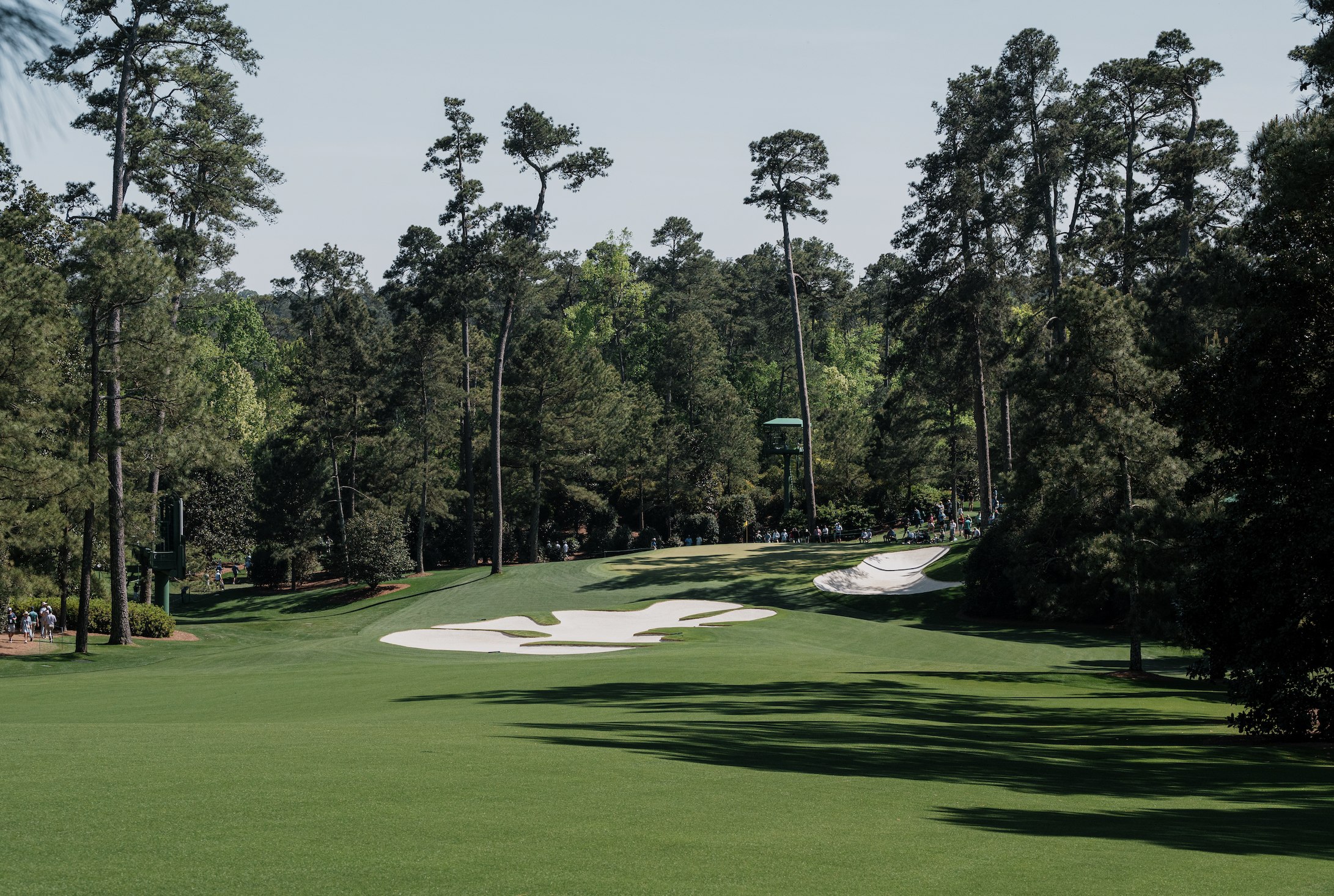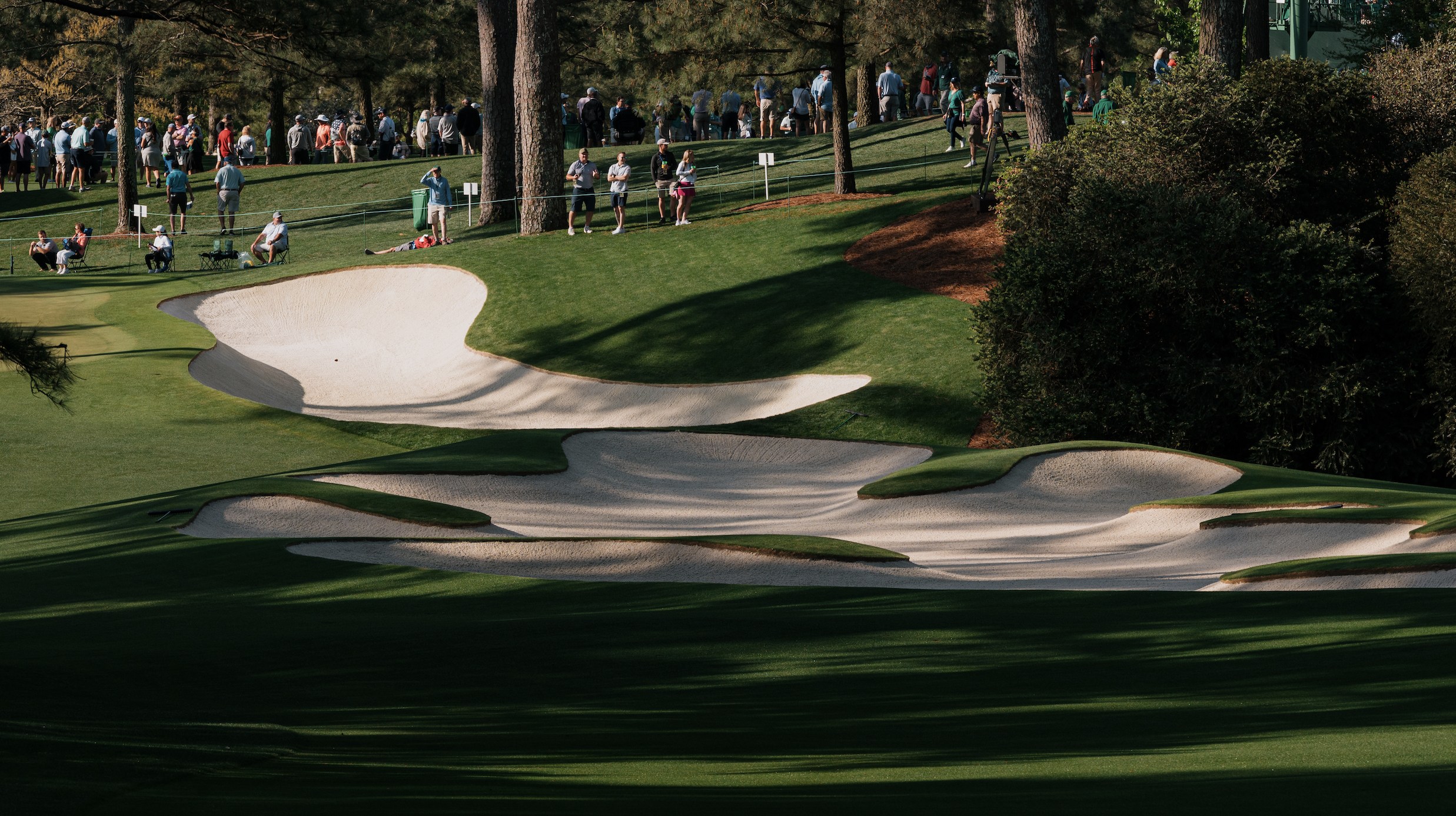Millions of people tune into the Masters every year, but very few know what it feels like to play Augusta National in competition.
In 2019, eight-time Masters competitor Geoff Ogilvy joined the Fried Egg podcast for an in-depth look at every hole at Augusta National. We recommend listening to the full podcast, as Geoff is one of our favorite guests, but we thought it would be useful to compile some of his wisdom into written form. This way, as you watch the Masters, you can have intel on every hole, even if the broadcast isn’t providing it.
First, though, a scene-setting quote from Mr. Ogilvy: “Where we have breakfast, it looks out over the first tee, down the 18th, and across to the 2nd green. You have that beautiful view across the golf course, and you have your coffee and your eggs. You can step out on the balcony as the gates open, and this swarm of humans goes across the golf course. It’s just one of the best experiences in golf. The whole course is full in [what seems like] five minutes.”
Does that get you in the mood or what? All right, on with the course tour.
“[The course] encourages you to take on shots you might not necessarily want to take on.”
No. 1 – Tea Olive – Par 4, 445 yards
“You can make bogey on the 1st hole at Oakmont and you don’t have to have done anything wrong. It’s just part of Oakmont, it hits you in the face on the 1st hole and you move on. But the Masters, if you play the hole really sensibly you can get a nice birdie putt on the 1st. But if you hit it anywhere other than directly under the hole, you have the hardest par in the world.”
“The 1st green might be the hardest green on the course, certainly the hardest 1st green in tournament golf. It’s really hard to hit the ball under the hole because of the way the front half of the green is. If you hit it short of a lot of pins, it rolls off the front. It encourages you to get it to pin high or just a bit past it.”
No. 2 – Pink Dogwood – Par 5, 575 yards
“My mentality was that if I could get it in that front-right [green-side] bunker or around that front-right bunker in two, I was happy. You can get it anywhere on the green close to the hole from around the front-right bunker.”
“I missed the green left a couple times… and worked out that’s really not where you want to be.”
“The Sunday pin might be the funnest pin on the course.”
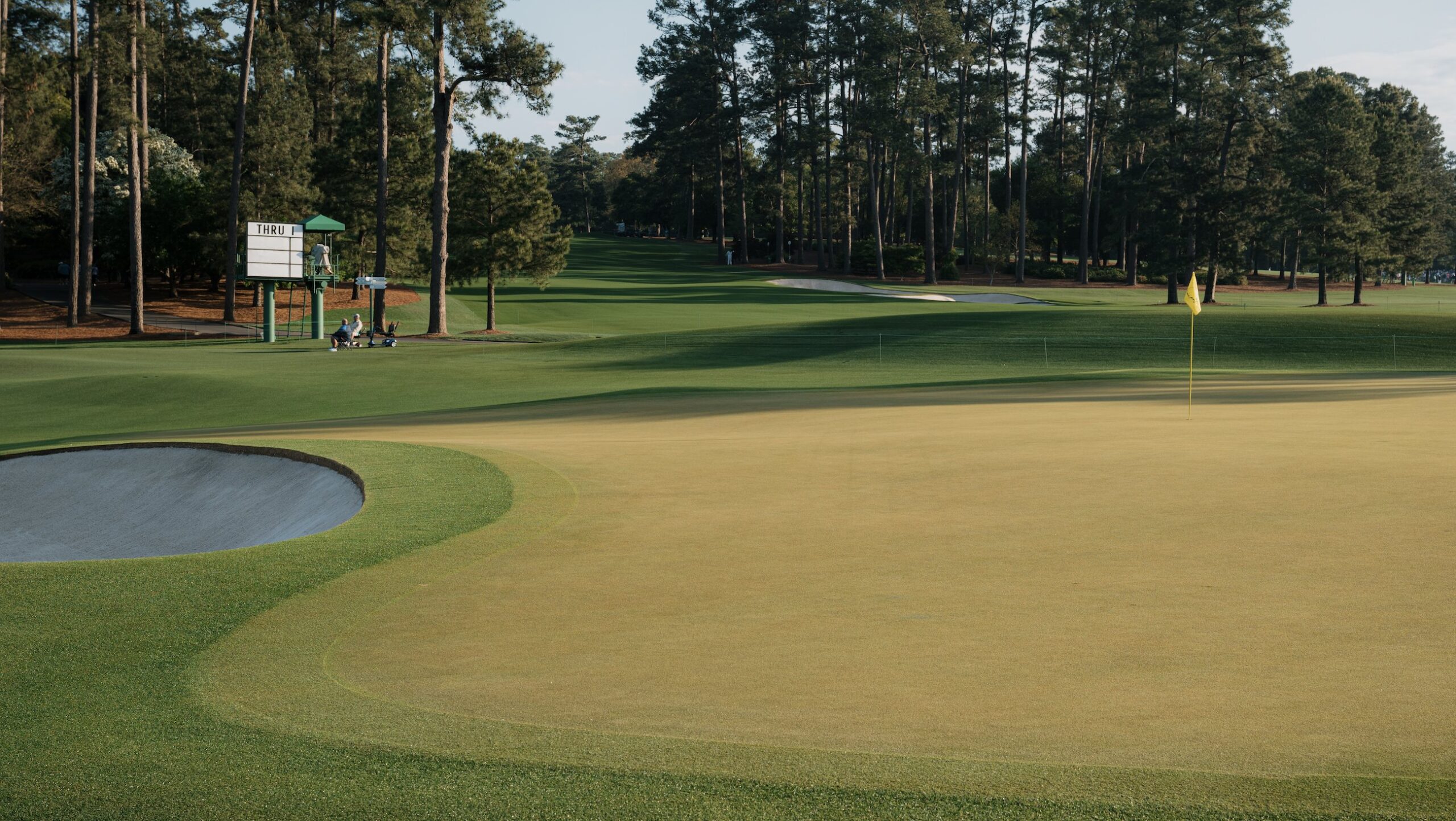
Right of No. 2 green at Augusta National
No. 3 – Flowering Peach – Par 4, 350 yards
“The 3rd I think is a genius hole because the only way to really make birdie or get it close is to risk missing it short of the green. And if you miss it short of the green, it’s almost an impossible up-and-down. It comes all the way back and you’re 12 feet below the level of the green to this crazy pitched green. And the only way to get that pitch close, if you do miss it short, is to risk leaving it short again.”
“If you miss [the green] in the wrong spots, you have almost zero chance to make par and a big chance to make 6, 7, or 8.”
No. 4 – Flowering Crabapple – Par 3, 240 yards
“You certainly want to be under before you’re over [at Augusta National]. You want to be -1 on the 4th tee, maybe -2.”
No. 5 – Magnolia – Par 4, 495 yards
“Five is even harder now, but it’s always been tricky.” (This was Geoff’s only note on the hole.)
No. 6 – Juniper – Par 3, 180 yards
“When the pin is low on the bottom tier, [6 is a birdie hole]. With the pin on the high [back] tier, that crazy high thing on the right, that is one of the toughest 6- to 8-irons you’ll ever have.”
“The only way you can really hit a great shot to those really small [landing areas], to hit those really precise shots, is to swing it free and loose. It’s hard to get into a free and loose mindset when you know all the bad things that can happen.
-
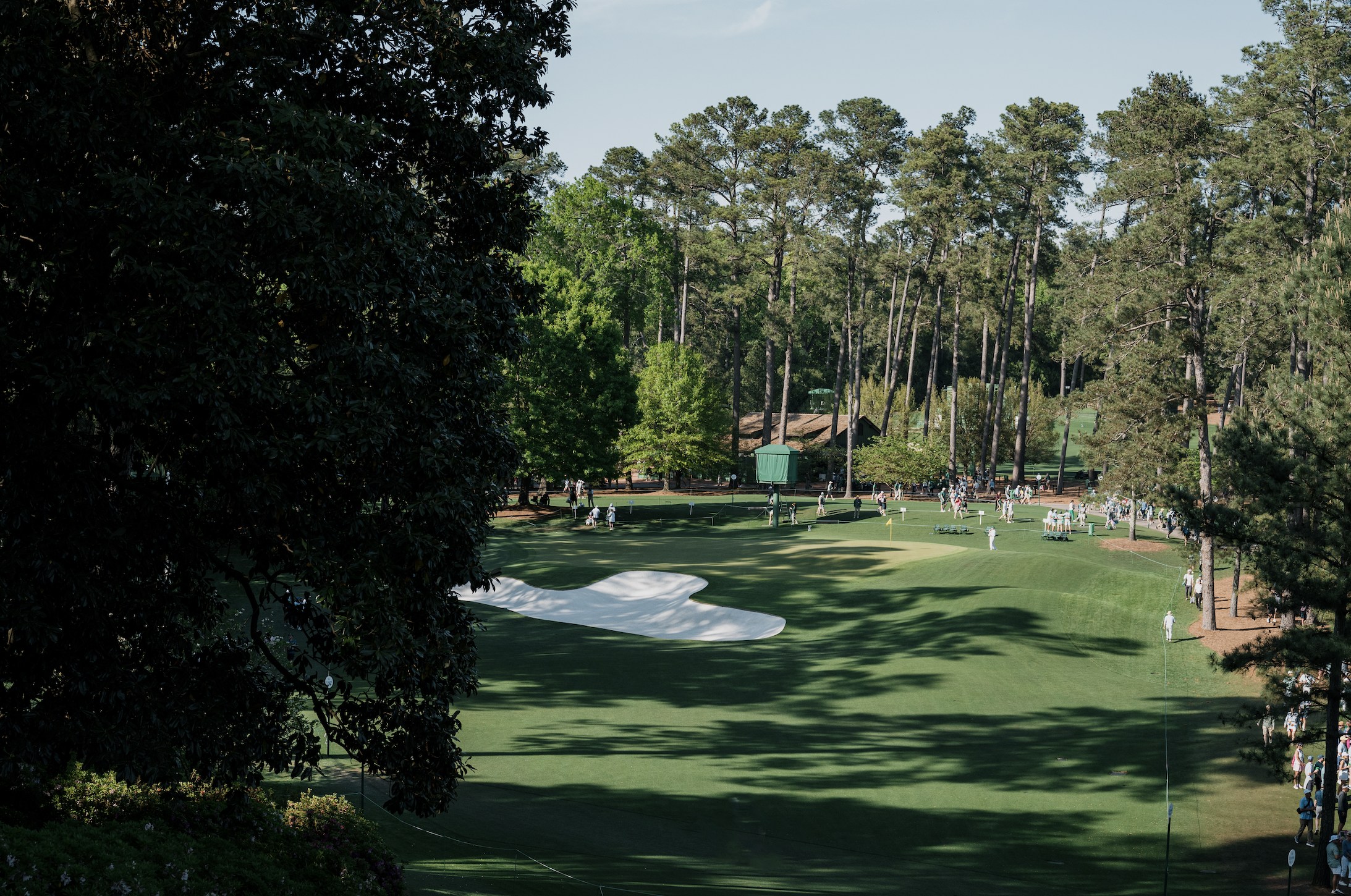
Looking down the hill on No. 6
-
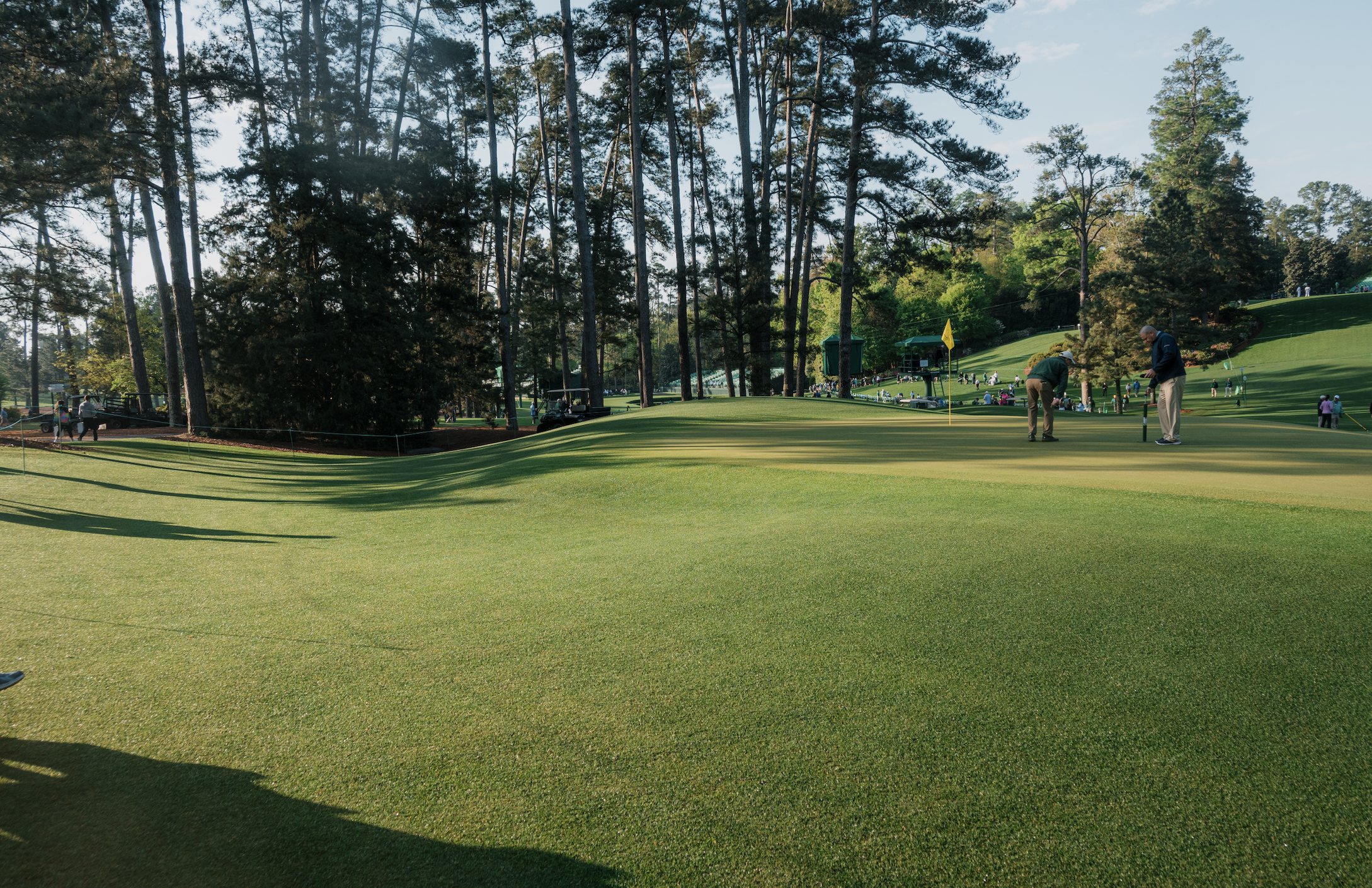
Behind the difficult back-right pin on No. 6
No. 7 – Pampas – Par 4, 450 yards
“With the pin high on the left over the bunker, where it crowns off both ways, it’s hard to hit it close. If it’s playing a little bit long and it’s early in the morning and you get a 5-iron into there, it’s a really hard hole.”
No. 8 – Yellow Jasmine – Par 5, 570 yards
“Strategically, the [8th hole] ticks every box. The more risk you take off the tee [the closer you are to the bunker], the less you have to hook your second shot to get it on the green. It’s exactly the same on the second shot. If you take no risk on the second shot [and lay up], the further right you go, the harder your wedge. The further left you go, the easier your wedge in, but you risk going left into the flowers and the rubbish. But there’s no real trainwreck on No. 8. Even if you hit in the trees left off the tee, you kinda punch it up the hill and hit whatever you can to the middle of the green [on your third shot].”
“It’s a really brave shot, the second shot. You’ve got to hook, quite solidly, some sort of 3-wood to get up near the green or anywhere close to the hole. That’s a really difficult shot off an upslope. Whenever you try to do that off an upslope, you generally miss it right. That hole allows you to miss it right, so your brain says, ‘It’s okay if I don’t hit this [perfectly].’ So everyone generally flails it out to the right.”
“You can lay up as far right as you want to. You have a football field right of the green to hit your second into. It’s quite a receptive green to hit it within 25 feet because it’s high on both sides. It doesn’t repel balls; it brings them back towards the hole. To hit it inside six feet in three [shots] is tough, but to get it within 30 feet for birdie is quite easy.”
No. 9 – Carolina Cherry – Par 4, 495 yards
“[The drive] is easy if you can turn it over right to left. It’s another one of those holes that coaxes you into trying to take on more than you need to. You really want to hit a big, high draw because it goes further with a forward bounce. It’s a relatively easy fairway to hit.”
“If you flare it a little [to the right], it’s easy to hit it in the right trees, but you end up with this downslope, ball below your feet, 6-iron into a green that isn’t fit for that setup. You get a downslope, fade lie, but the shot requires a high draw.”
“It’s almost impossible to hit it over the 9th green. It plays quite long, and it effectively plays uphill because you’re playing off such an extreme downslope. You’re off such a downslope that it’s hard to get it in the air on the second shot. So it hits the ground before it normally would and it isn’t bouncing forward unless it lands [on the green].”
No. 10 – Camelia – Par 4, 495 yards
“It’s one of my favorite holes to play. It’s a fun tee shot, you want to hit it [right to left], but if you don’t it’s not the end of the world.”
“The second shot on 10, unless you really smash [a drive] down the left and have a short iron in, the second shot may be the hardest swing on the course. Downslope, ball above your feet, [long iron], to a green that looks miniscule from up there.”
“You have to swing free on that second shot on 10 because it makes you want to be careful. You get a low draw lie and the shot really requires a high fade.”
“Really to play 10 great, you don’t have to fade it into the green, but it lands softer and is a bit more receptive. But [right-handers] have to draw it off the tee and hit a fade on the second shot.”
“It’s rather difficult to work out where the miss is at the Masters, and it’s always difficult to hit it there.”
No. 11 – White Dogwood – Par 4, 505 yards
“The tee shot got narrower when they added the trees on the right, but it’s still a wide fairway even with [those] trees. It encourages you still to drive it up the right, but really on 11 guys are just trying to hit the fairway.”
“If you watch practice rounds at the Masters, on No. 11, every group that comes through is hitting a ton of pitch shots [from short right of the green] because you know you’re going to be there two or three times. That whole green is [tilted] towards the water on the left. You’re chipping uphill, not a lot, but enough, to a really steep downslope. The real tricky thing at the Masters, and that’s the spot where it’s most evident, is the fringes are quite slow and the greens are quite fast.”
“[The chip from right of the green] is a really scary shot because of the thin grass and water past. The safe play is to bump it along the ground to get it rolling, but the fringe catches really fast. If you force it just a little bit and you want three bounces but it only takes two, well then it’s going straight in the pond.”
“It’s a little un-talked about: you can’t just hit it short of the green because anything short of the green hits the mounds short of the green. Anything that hits those mounds—it doesn’t always but it can—it hits those mounds and goes left into the pond.”
No. 12 – Golden Bell – Par 3, 155 yards
“The wind is an element that has really made the hole famous, but without that, the genius of the hole, especially because most golfers are right-handed, is that short right is in the water and long left is over the green. And a right-hander, when they miss it left it goes long, and when they miss it right it goes short.”
“[The wind] seems to come down 13 fairway around the bend, hit the wall of trees [behind the 12th green], and bounce back towards the tee. You know [the wind] is supposed to be down off the right, but one minute out of every three, it can play into the wind because it bounces off that big wall of trees and it holds up the ball.”
“The middle pin and the left pin… if it’s not too windy, it isn’t that difficult.”
“Nicklaus always said hit it over the bunker, go left of the [right pin] and go from there. That’s a great theory, but the middle of the green is short of where the [right] pin is. So if you pick that line and miss it right, you’re going to go in the water.”
“The most beautiful noise in golf is when you’ve made a putt on 12, and there is that speed-of-sound gap. You’ve got that three seconds until you hear the cheers. There is something about it that is really rare in golf.”
No. 13 – Azalea – Par 5, 510 yards
“[The 13th tee box] is the best place in professional golf by a long way. You’re tucked away, no one can see you, and you’re looking at the most beautiful tee shot in the world.”
“A professional in the Masters would never not make 5 if his goal was to make a 5. It’s really quite easy to hit the middle of that green in three shots, but you’re never going to make 4.”
“I wasn’t that great at hitting big draws with drivers, so I was willing to accept a 3- or 4-iron into the green. As I said, you go left once or twice and you feel like you’ve wasted a shot or two, and you’ve missed out on probably the funnest shot on the course.”
“It’s probably the perfect golf hole, and if it isn’t the perfect golf hole, it’s as close as you can get to a perfect golf hole. Strategically, the closer to the water you get [off the tee], you get a three-fold advantage. You get a flatter lie, you’re closer to the green, and you have a better angle. The further away from the creek you are, the further away from the hole you are, the further the ball is above your feet, the worse your angle into the green.”
“It’s incredible how much the ball is above your feet on that second shot. It’s hard to hit it high, and because the trouble is short left and [the creek] goes long right. If it was a flat lie, you’d want to hit a fade into that green, because you could hit a shot that was basically never [at risk] of going in the water. You could start it left of the green, the shortest carry [over the creek]. You could hit a safe one and say, ‘Well, if I hit it straight, I’ll just miss the green left and I can kind of birdie from over there.’ But you have to, with the ball above your feet, kind of hit a draw. So you’re hanging it over the long carry and you’re hanging it over the water. You’ve got this shot where all you want to do is hit a high fade and all the stance wants to give you is a low draw.”
One of the best approach shots ever hit on Augusta National's 13th hole.@WakeWGolf's Emilia Migliaccio remembers former teammate Jennifer Kupcho's impressive shot like it was yesterday. #ANWAgolf pic.twitter.com/5ZOuiJxx15
— Golf Channel (@GolfChannel) April 2, 2021
“It doesn’t look like it when you’re standing [in the fairway], but the water in the creek [on the 13th] runs quite significantly and quite fast from the green towards Rae’s Creek. It runs back towards the tee. So it’s obviously quite uphill, the second shot. It would definitely play five or 10 yards longer than it measures just because of the hill.”
No. 14 – Chinese Fir – Par 4, 440 yards
“When they made it longer, I think the tee shot got a little bit easier. That and when they started to cut the fairways back towards the tee. In the old days, from what I hear, is that you had to hit a draw to keep it on the fairway. The fairway is quite high on the left and quite low on the right so anything that is straight or a fade is going to hit and run to the right. The [added] length actually made [the fairway] a little easier to hit because it’s quite hard to hit it in the trees now.”
“I felt it’s a relatively simple tee shot, and then the second shot changes every day depending on where the pin is.”
“It’s probably the green that freaks people out the most.”
“That famous pin in the middle that they have on Sundays, where anything 20 or 30 feet left of it just rolls towards it, that’s a really fun pin to hit at. But you can get it wrong, because if you get it two feet right of the pin you’re going to have a 60-footer from the bottom right of the green. That might be the slowest putt at Augusta.”
“You can’t miss the green short. If you miss the green short, it might be a one-in-five up-and-down.”
“It’s a [green] you want to hit a draw into because you want the draw to hold the slope when it lands, but the ball is so far below your feet on the second shot that it’s really difficult to hit a draw.”
“The slow putts at the Masters are the hard ones because you’re so afraid of the one coming back if you smash it.”
No. 15 – Firethorn – Par 5, 530 yards
“It’s the hole where, on the tee, you do everything you can to be able to go for it in two. Because as hard as that second shot is, and as much trouble as there is with that second shot, getting it over the water in two and on dry land is preferable to anything short of the water. There is nothing good short of the water. It is the hardest wedge in golf by a long stretch.”
“Trainwrecks happen on the third shot generally, not the second shot.”
“The instinct when the pin on the left is to lay it up down the right. You feel like you can kind of create a bit more room on the green. But the further right you are on the fairway with that wedge shot from 100 yards or 80 yards, you are landing it on a pretty significant downslope of the green from right to left. And that first bounce is so big, that if you land it anywhere near the pin, it’s just one bounce and over the back.”
“I would go out of my way to lay it up as far left as I can. Even the semi-rough is better than anywhere on the right. The further left you are, the flatter your stance. If you go way left and have a distance where you can get some spin, even to that back-left pin, you can hit a pitch that lands 20 or 30 feet right of it and spins left because it comes back down the hill.”
“The pins on the right are the easy pins. That Sunday pin on the right is the eagle pin. The green is very, very fast from right to left, and the green is progressively shallower as you go to the left. The right-hand side, it seems like you can stop a 3-iron. On the left-hand side, it feels like you can’t stop a wedge.”
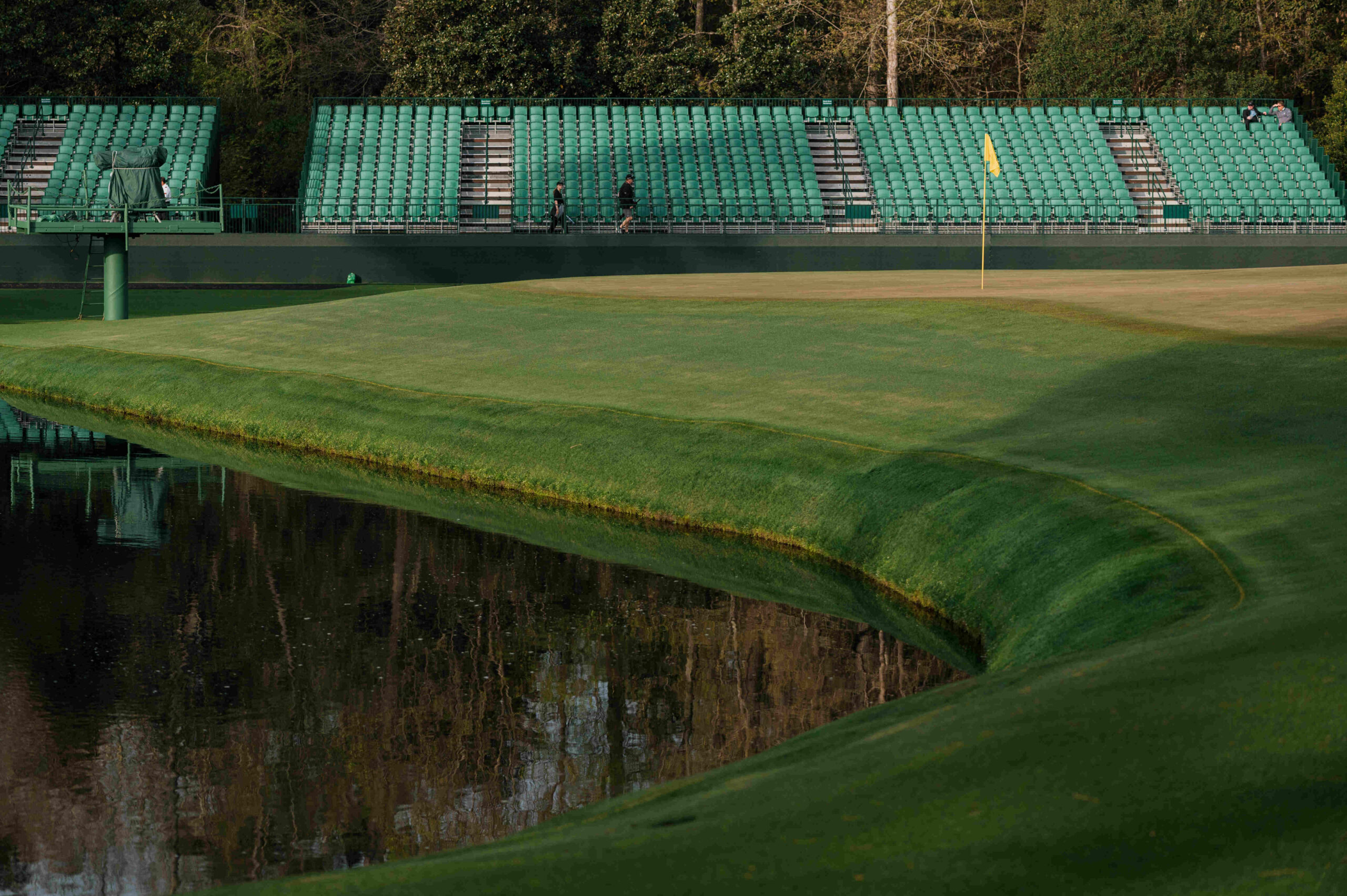
Many a player have found a watery grave on No. 15
No. 16 – Redbud – Par 3, 170 yards
“The two easiest pins and the two hardest pins on the course might all be on No. 16.”
“The two low pins, generally Thursday and Sunday, are really fun. Anywhere 30 or 40 feet right of the hole goes towards the pin. That front-right pin on Friday and the back-right pin on Saturday are excruciatingly difficult.”
“You really just have to try to hit the great shot [to the front-right pin], and always with the thought in your mind that you don’t want to be 25 feet past the hole in the bottom bowl. From Sunday’s pin (middle left) to Friday’s pin (front right) would be a one-in-10 two-putt.”
“The Saturday pin, the Nicklaus in ’75 pin, is an incredibly small area. Anything left of the hole is going left towards Sunday’s pin. I don’t know how many balls could land left of the hole and stay [on the top shelf].”
“To make the hole-in-one [on the Sunday pin], you almost have to hit it long of the pin. But if you pull that, you’re over the green or on the back edge.”
No. 17 – Nandina – Par 4, 440 yards
“Relatively easy tee shot, but it’s a tee shot that really gets your attention. It’s another one of those that you really want to hit it hard and hit a good one. You get a big advantage by getting it to a certain distance because [you’ll land it] on a flat and the ball runs out a bit. If you hit it 10 yards shorter, it just hits and stops. Then you’ve got a semi-blind 6-iron into the green from an upslope.”
“Seventeen might be my favorite green on the course. Over the back of the right-hand side is completely terrible. When the pins are on the right half of the green, you have to miss it short of the pin. If the pins are on the left, you actually want to miss past the hole. It’s a back-to-front green on the right and it’s a front-to-back green on the left.”
“A lot of people hit it in that front-right bunker to right pins because if you’re between clubs, you have to pick the shorter one. You can get it up and down from the front right. It’s difficult, but you can. You just can’t from long right”
“The putt from the left side of 17 green to the right, it seems uphill, but it’s actually quite downhill. Or at least it plays downhill because of the grain or the slope.”
No. 18 – Holly – Par 4, 465 yards
“It’s a tough tee shot, but for me, it was always one of the more comfortable tee shots on the course. My miss was always to the right if I didn’t smash it. After they made it longer, I struggled to get it to the bunkers. These big drawers, guys who struggle to move it left-to-right, it’s a tricky tee shot.”
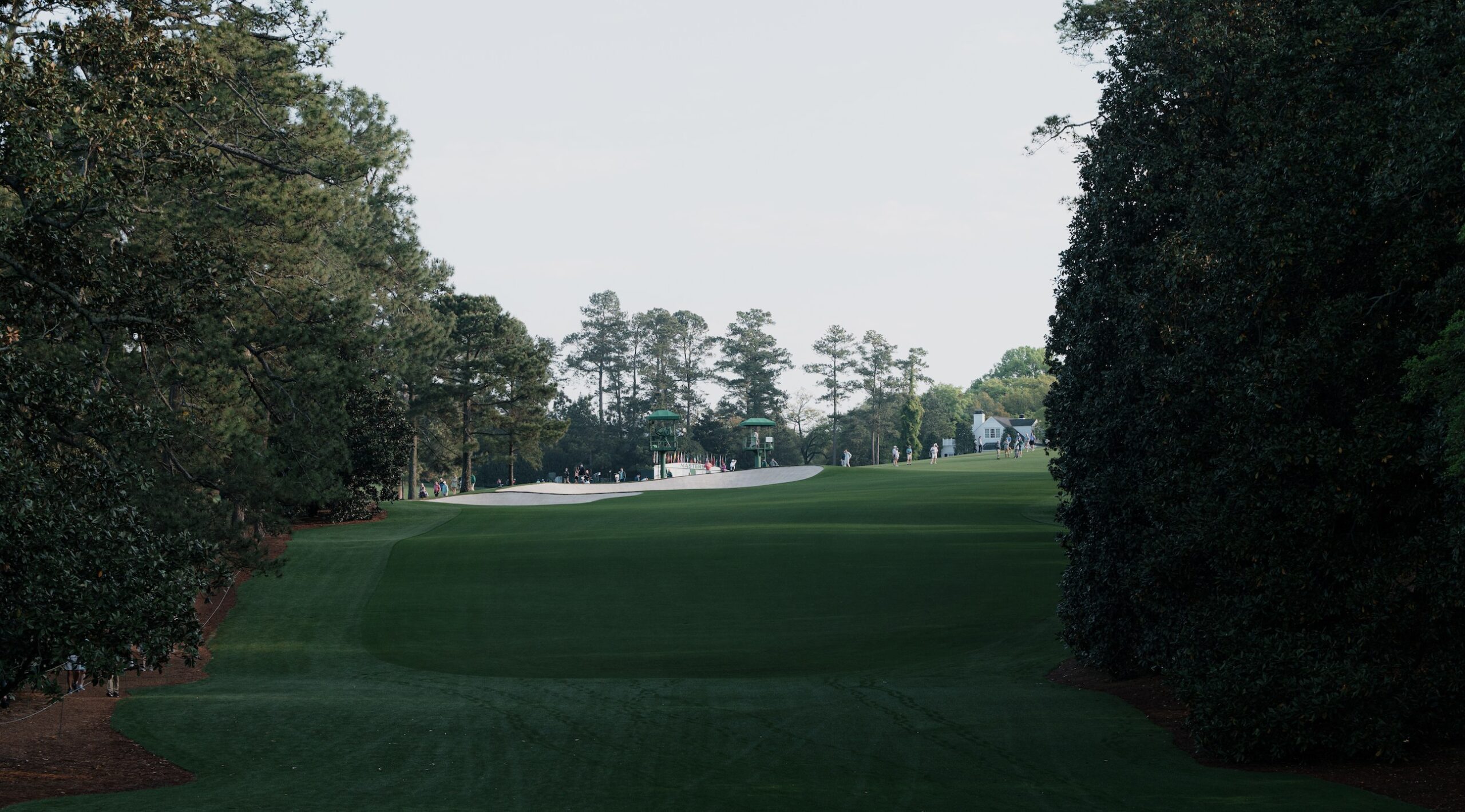
The 18th tee shot at Augusta National
“The second shot I always found difficult because it’s a really extreme uphill that you’re hitting it off. There isn’t a good miss on 18 on the green. Maybe over the green to back pins.”
“That front pin, where a lot of people make birdie, you’ve got probably a 30-foot circle to hit it. If you miss that 30-foot circle, you’re going to have some problems.”
This piece originally appeared as part of Fried Egg Golf’s 2021 Masters coverage. Visit our site hub for more insight and analysis on Augusta National and the Masters.
More Masters coverage from the Fried Egg Golf team:
Ranking the Chasers for the 2024 Masters
An Early Scouting Report from Augusta National
Paulie’s Picks: Masters Favorites
Find all FE Masters content in our Masters Hub


 by
by 